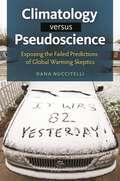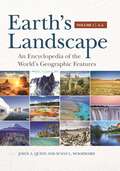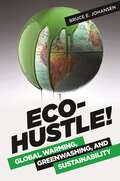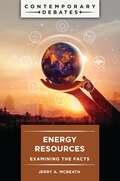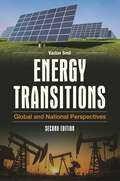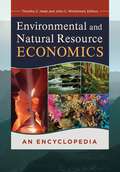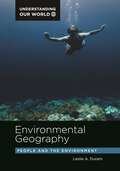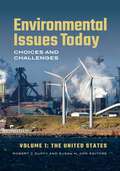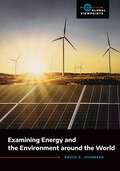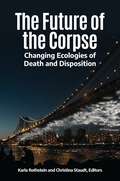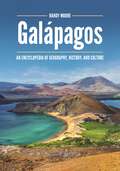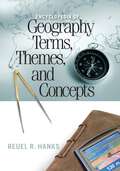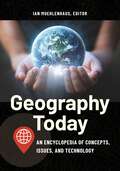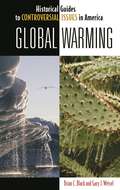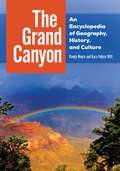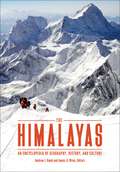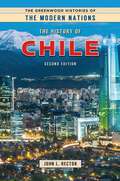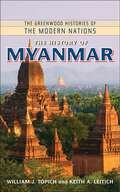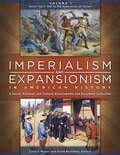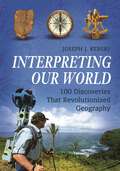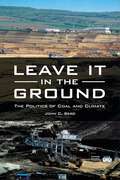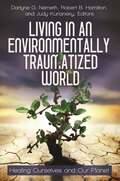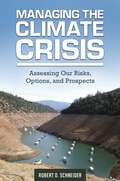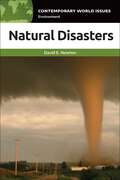- Table View
- List View
Climatology versus Pseudoscience: Exposing the Failed Predictions of Global Warming Skeptics
by Dana NuccitelliThis book explains the science of climate change in plain language and shows that the 2 to 4 percent of climate scientists who are skeptical that humans are the main cause of global warming are a fringe minority—and have a well-established history of being wrong.Although some politicians, pundits, and members of the public do not believe it, global warming predictions by mainstream climate scientists have been remarkably accurate while those made by climate deniers have not. And if mainstream global warming predictions continue to prove correct, the window of opportunity to prevent a climate catastrophe is quickly closing. This book is the first to illustrate the accuracy—and inaccuracy—of global warming predictions made by mainstream climate scientists and by climate contrarians from the 1970s to the present day. Written in simple, non-technical language that provides an accessible explanation of key climate science concepts, the book will appeal to general audiences without previous knowledge about climate science.Author Dana Nuccitelli, an environmental scientist and risk assessor, discusses some key climate discoveries dating back to the 19th century and debunks myths such as the idea that climate scientists and climate models have grossly over-predicted global warming. He addresses recent findings of a 97-percent consensus in the peer-reviewed scientific literature that humans are causing global warming—a nearly unanimous agreement that formed in the early 1990s and has grown through the present day. Nuccitelli also discusses what the future climate might look like if current trends continue unabated, and what we as a global society need to do to prevent a climate catastrophe.
Earth's Landscape [2 volumes]: An Encyclopedia of the World's Geographic Features [2 volumes]
by Joyce A. Quinn Susan L. WoodwardThis unusual encyclopedia brings together in-depth information on more than 450 natural geographic features from around the world and offers an array of creative tools to promote critical thinking and classroom discussion.With Earth undergoing rapid environmental change, students and the general public alike should be knowledgeable about the world's geographic features. This authoritative, two-volume reference enables readers do just that. It describes continents and oceans; individual mountains, islands, caves, and rivers; and ecological entities such as wildlife refuges and national parks. Each entry provides a geographic overview of the feature's significance, location, description, geologic history, biota, protected areas, and environmental issues. But the coverage goes even deeper so that entries also discuss the cultural importance of each natural place, covering everything from indigenous beliefs to traditional folklore to contemporary legends.The encyclopedia stands apart from other works not only in the depth of its coverage but also in its range. It discusses lesser known as well as prominent geographical features and offers critical thinking aids that will help students see how the natural world relates to their daily lives. Teaching and learning tools include an appendix called "Opposing Viewpoints" that allows students to understand landforms involved in current conflicts and disputes as well as an "Activities/Discussion Questions" appendix.
Eco-Hustle!: Global Warming, Greenwashing, and Sustainability
by Bruce E. JohansenHow many of our efforts to save the environment are effective? Learn how our system is simply masking the symptoms of global warming.Climate change is more than just a buzzword. It is a reality that society and industry have failed to deal with effectively. "Greenwashing," a term that author Bruce E. Johansen defines as the "environmental sleight of hand" performed by technology and advertising, has us convinced that certain "green" practices are sustainable. In his book, Johansen examines the sanctioned activities and practices commonly touted as environmentally responsible and points out their failings. He explains why the global climate change problem is more urgent than many people think, and provides real-world examples of companies that are taking measures with genuine benefits to the environment.Presenting information relevant to every inhabitant of earth and that environmentalists, climate scientists, and students and educators in environmental studies will find essential reading, this book brings questions about legislation and economics to the forefront and asks whether today's system can support a true effort at sustainable living. It presents honest—and what some readers may find surprising—answers to inquiries into what is really "good for the environment," such as why corn ethanol may be worse for the atmosphere than oil and why coal capture and sequestration may be the worst "green" idea yet.
Energy Resources: Examining the Facts (Contemporary Debates)
by Jerry A. McBeathEnergy Resources: Examining the Facts provides an authoritative, comprehensive overview of economic, political, and environmental drivers of America's energy picture, from trends in the production and consumption of fossil fuels and renewables to the state of the national energy grid.Energy Resources: Examining the Facts is part of a series that uses evidence-based documentation to examine the veracity of claims and beliefs about high-profile issues in American culture and politics. Each book in the Contemporary Debates series is intended to puncture rather than perpetuate myths that diminish our understanding of important policies and positions; to provide needed context for misleading statements and claims; and to confirm the factual accuracy of other assertions.This installment in the series provides a comprehensive overview of all energy resources used in the United States, including fossil fuels (oil, gas, coal), nuclear power, hydropower, other major renewables (solar and wind), and even smaller energy sources, such as wood products (biomass), ethanol, plant-based fluids/gases, and geothermal, that have meaningful potential for future growth. The framework of laws and regulations in which energy resources are developed, produced, and overseen is described, as are the ways in which economic development powered by different energy resources is impacting people and ecosystems in the United States and around the world.
Energy Transitions: Global and National Perspectives
by Vaclav SmilThis book provides a detailed, global examination of energy transitions, supplying a long-term historical perspective, an up-to-date assessment of recent and near-term advances in energy production technology and implementation, and an explanation of why efforts to limit global warming and to shift away from fossil fuels have been gradual.Based on the best international and national statistical sources, the second edition of Energy Transitions: Global and National Perspectives supplies an in-depth evaluation of how economies and nations around the world are striving to move away from traditional energy sources, the unfolding decarbonization process, and problems with intermittent energies and national transition plans. It supplies readers with a clear introduction to the basic properties of energy systems and key concepts of their appraisal, puts energy transition patterns in long-term historical perspective, and looks at the energy transition in eight of the world's leading economies. The last chapters focus on the advances in the decarbonization of the global energy supply and consider how the energy transition will continue in the coming decades.This fully updated and substantially expanded edition addresses the many new developments affecting energy supply, such as the recent expansion of hydraulic fracturing, oil price fluctuations, the Fukushima nuclear power plant catastrophe, advances in solar and wind generation, adoption of combined cycle gas turbines, and increased availability of electric cars. The coverage highlights the differences in the pace of transitions in various countries, thereby providing a complete and accurate picture of the current state of energy development in different parts of the world. The book serves as an invaluable resource for students as well as for anyone interested in a realistic appraisal of the current state of energy transitions in various nations and regions and the likely future development of the global energy supply.
Environmental and Natural Resource Economics: An Encyclopedia
by Timothy C. Haab and John C. WhiteheadAccessible to students and practitioners without an advanced degree in environmental economics, this essential reference work pinpoints the role of the economy in both creating and solving many of the world's most pressing environmental challenges.Given the number and scope of environmental problems we face today, everyone from high school students to policy makers to concerned citizens should understand how the economy works and grasp how meltdowns—both economic and environmental in nature—can be avoided. Environmental and Natural Resource Economics: An Encyclopedia offers the critical information needed to comprehend these complex issues. The entries cover topics in a manner parallel to how environmental economics is commonly taught, addressing basic concepts, environmental policy, natural resource economics, market failure, exhaustible and renewable resources, benefit-cost analysis, and applied welfare economics. Additionally, the book includes entries on key concepts of economics, movements, events, organizations, important individuals, and research areas relevant to the study of environmental and natural resource economics. This work stands alone as the only title currently offering such a breadth of coverage and level of detail written specifically for readers without specialized knowledge of environmental economics.
Environmental Geography: People and the Environment (Understanding Our World)
by Leslie A. DuramExplores the complex relationship humans have with the environment. It is one of both responsibility—including the sustainable or unsustainable management of natural resources—and emotion, like the elation gleaned from a beautiful landscape or the devastation experienced from a natural disaster.Human-induced damage to the environment has widespread consequences for Earth and its inhabitants that have already included sea level rise, increased wildlife extinctions, heatwaves, droughts, intensified air pollution, and water shortages.This book provides comprehensive coverage of the complex interactions between people and the environment. It presents three clear, honest, and down-to-earth essays that cover the devastating impact humans have on the environment; the equally devastating impact the environment has on humans at times; and the positive impact that increasing awareness of our effect on the planet is having on the movement to create a more sustainable future. In addition, in-depth entries on 60 key environmental geography terms, such as deforestation, ecotourism, and environmental justice, provide a deeper dive into the topic; 15 real-world case studies on topics like the Great Pacific Garbage Patch and the Great Green Wall of Africa illustrate geography in action; and 10 brief spotlights from around the world draw the reader in with relevant facts.
Environmental Issues Today [2 volumes]: Choices and Challenges [2 volumes]
by Robert J. Duffy and Susan M.This two-volume set provides an authoritative overview of the major environmental issues of the 21st century, with a special focus on current challenges, trends, and policy choices.This set provides an up-to-date, comprehensive, and focused resource for understanding the nature and scope of environmental challenges facing the United States and the world in the 21st century, as well as options for meeting those challenges. Volume One covers environmental trends and challenges within the United States, while Volume Two illuminates environmental issues and choices around the world. Issues covered in both volumes include vital topics such as climate change, air and water pollution, natural resource and species protection, and agricultural/industrial impacts on the environment and public health. For all topics, the authors—scholars and experts hailing from a wide range of environmental and policy fields—detail a range of political, social, and economic options for the future and explain why the issue in question is important for society and people as well as the natural world.
Examining Energy and the Environment around the World (Global Viewpoints)
by Bruce E. JohansenThis volume addresses ten issues pertaining to energy and the environment, such as climate change, fossil fuels, endangered species, and renewable energy, and examines how these issues are affecting countries around the world.In the industrial age, first powered by coal and then more often by oil, environmental degradation nearly inevitably followed resource exploitation and energy production. This book examines environmental issues in specific countries around the world as well as solutions some of these countries have discovered in order to help save the environment.This volume includes 10 chapters, each addressing a specific issue relating to energy and the environment as it pertains to a variety of countries, including toxic chemicals, pollution, deforestation, and climate change. Each chapter begins with an introduction to the issue. Following the chapter introduction, each chapter highlights that issue in eight countries and provides historic perspective. This work provides an overview for high school students and college students at the undergraduate level on 10 important topics that address matters relating to energy and the environment in the 21st century.
The Future of the Corpse: Changing Ecologies of Death and Disposition
by Karla Rothstein and Christina StaudtThis book reviews the spectrum of death, from when the living person turns to corpse until the person lives in the memory of mourners, and its impact on the ecology of the socio-cultural community and physical environment.This book demonstrates that American society today is in a pivotal period for re-imaging end-of-life care, funerary services, human disposition methods, memorializing, and mourning. The editors and contributors outline the past, present, and future of death care rituals, pointing to promising new practices and innovative projects that show how we can better integrate the dying and dead with the living and create positive change that supports sustainable stewardship of our environment. Individual chapters describe prevailing practices and issues in different settings where people die and in postmortem rituals; disposition and current ecologically and, in urban areas, spatially unsustainable methods; law of human remains; customs and trends among key stakeholders, such as cemeteries and funeral directors; and relevant technological advances. The book culminates in a presentation of emerging sustainable disposition technologies and innovative designs for proposed public memorial projects that respond to shifting values, beliefs, and priorities among an increasingly diverse population.
Galápagos: An Encyclopedia of Geography, History, and Culture
by Randy MooreThis encyclopedia provides readers with a comprehensive look at the Galápagos Islands, from the wildlife and scientists that made them famous to the challenges and issues the islands face today.In the mid-1800s, the Galápagos Islands served as Charles Darwin's playground, a volcanic archipelago where he famously worked on his theories of evolution and natural selection. But who actually discovered the islands? Why didn't any country claim them for more than 200 years? And is ecotourism hurting or helping these mysterious islands?This volume explores the history, science, and culture of the Galápagos Islands. A Preface, Introduction, Chronology, and Galápagos at a Glance primer introduce readers to the islands that are so famously associated with Charles Darwin. Twelve thematic essays allow readers to explore such topics as evolution, the geology of the islands, invasive species, and tourism in depth. Topical entries follow, covering key individuals and organizations as well as other important concepts and ideas.Thirteen primary document excerpts allow readers to study firsthand accounts from explorers and visitors to the islands. Appendices, a glossary, a bibliography, and sidebars round out the text. Students of history, geography, and science will find this volume informative, while general readers will be intrigued to learn about these unique islands.
Encyclopedia of Geography Terms, Themes, and Concepts
by Reuel R. HanksThis text provides an essential reference handbook for students of geography and related social sciences.How did the Greek geographer Eratosthenes make an accurate calculation of the earth's circumstance more than 1,500 years before the first voyage of Columbus to the New World? What are the "green belts" of England that dominate its rural landscape? And what is regarded as the driest continent on the planet?This handbook offers a broad coverage of terminology and concepts, serving as both an encyclopedic dictionary of geography terms and an approachable overview to the human and physical aspects of world geography. Approximately 150 geographic terms and concepts are defined and discussed, providing an accessible reference for anyone who requires a deeper knowledge of the language and ideas that are important to geography as a discipline. Helpful sidebars are provided to shed light on unusual or controversial theories and concepts. All major geographic concepts and terms are addressed and comprehensively explained using examples.
Geography Today: An Encyclopedia of Concepts, Issues, and Technology
by Ian MuehlenhausGeography Today provides a thoughtful and thorough introduction to the study of geography—from maps and technology to the study of different cultures, political systems, and economies, and an investigation of plate tectonics and climate systems.Geography Today: An Encyclopedia of Concepts, Issues, and Technology approaches the study of geography by concept, in contrast to most other works, which are organized by world region. Geography curriculums have been moving away from teaching the topic on a regional basis and toward teaching it through broader concepts. This is modeled by the National Geography Standards, the National Council for Geographic Education's Roadmap for 21st Century Geography Education, Texas Essential Knowledge and Skills Resource System, and ABC-CLIO's own geography advisory board, comprised of high school geography teachers from across the United States. By introducing geography concepts, Geography Today sets the foundation for readers to understand why certain geographies may be the way they are. It further helps high school geography students to apply concepts to different contexts with 101 geography terms, themes, and concepts for quick-reference research and study.
Global Warming (Historical Guides to Controversial Issues in America)
by Brian C. Black Gary J. WeiselTracing scientific ideas about the structure of Earth, Global Warming creates an intellectual portrait of the shifts in thinking that have led to the current controversy, enabling readers to make up their own minds on this important issue.Global Warming takes one of the hot-button issues of our time and surveys it in historical context, creating an intellectual portrait of the multi-century shifts in thinking that have led to gradual acceptance of the concept. The book summarizes pertinent aspects of geology, earth science, and climate science in easy-to-read terms. It then frames this background in terms of cultural and social shifts, including the Industrial Revolution, conspicuous consumption, and modern environmentalism. In addition, a study of the ebb and flow of cultural and political reception relates the issue to religious and social ideas.The information presented here will enable the reader to understand the scientific case stating that human activity has caused an unprecedented warming in the late 20th and early 21st centuries. Technical and political objections to this thesis are also covered, so that readers may form their own opinions on this critical subject.
The Grand Canyon: An Encyclopedia of Geography, History, and Culture
by Randy Moore Kara Felicia WittThis single-volume encyclopedia examines the Grand Canyon in depth, from the native peoples who have survived there for centuries to the explorers who charted its vast expanses and to the challenges that Grand Canyon National Park faces.The Grand Canyon is one of the most internationally recognized landscapes and symbols of nature in North America. In this one-volume encyclopedia, readers can dive into the many people, places, stories, and issues associated with the Grand Canyon as well as the scientific, religious, and social contexts of events that have made the Grand Canyon what it is. At the front of the encyclopedia are thematic essays that examine the Grand Canyon's history, geography, and culture. Essays cover topics including John Wesley Powell, to whom the Grand Canyon "belongs," the Native Americans who live at the Grand Canyon, and the future of the Grand Canyon. Following the thematic essays are approximately 150 topical entries focusing on more specific aspects of the Grand Canyon, such as trails and camps, natural formations, and courageous heroes as well as shameless profiteers who have influenced the Grand Canyon's history. The encyclopedia is rounded out by a chronology of human history at the Grand Canyon, a Grand Canyon "at a glance" section, and multiple fact-based sidebars. Through the people, places, and stories explored in this work, readers will gain a better understanding of how the history of the Grand Canyon is relevant to the world today.
The Himalayas: An Encyclopedia of Geography, History, and Culture
by Andrew J. Hund and James A. WrenA thorough and detailed resource that describes the history, culture, and geography of the Himalayan region, providing an indispensable reference work to both general readers and seasoned scholars in the field.The Himalayas: An Encyclopedia of Geography, History, and Culture serves as a convenient and authoritative reference for anyone exploring the region and seeking to better understand the history, events, peoples, and geopolitical details of this unique area of the world. It explores the geography and details of the demographics, discusses relevant historical events, and addresses socioeconomic movements, political intrigues and controversies, and cultural details as to give an overarching impression of the region as a coherent and cohesive whole. Readers will come away with a vastly heightened understanding of the geographical region we recognize as the Himalayas, and grasp the issues of geography, history, and culture that are central to contemporary understandings of the human culture in the region.The alphabetically arranged and succinct entries provide easy access to detailed, authoritative information. Additionally, sidebars throughout the book relate compelling facts that point readers to new and interesting avenues of exploration. The volume also includes a chronological overview of the region, ten primary source documents, and a comprehensive bibliography of supporting works.
The History of Chile (The Greenwood Histories of the Modern Nations)
by John L. Ph.D.This accessible chapter book, ideal for students and general readers alike, examines the political, social, and cultural history of Chile.Updated and revised from its 2003 edition, The History of Chile serves as a foundational text for those studying and interested in learning about this South American nation. Eleven chronologically-arranged chapters will guide readers through Chilean history, from prehistory to present day. Chapters examine topics such as the origins of Chileans, Chile's period as a Spanish colony, Augusto Pinochet's rule, the country's transition to democracy, and today's challenges in 2018–2019. A timeline, glossary, and appendix of Notable Individuals in the History of Chile round out the text.Written for high school and undergraduate students, but accessible to general readers as well, this volume examines Chile's history through the lenses of politics, economics, and culture and society. Readers will gain a better understanding of how Chile has modernized its economy and is incorporating immigrants.
The History of Myanmar (The Greenwood Histories of the Modern Nations)
by William J. Topich Keith A. LeitichThis text provides a thorough examination of the history of Myanmar from Neolithic times to the present.Myanmar has experienced a seemingly endless series of conquerors, dating from prehistoric times through the reign of Kublai Khan's Mongol forces beginning in the late 1200s, all the way through the modern era, when it was subject to both British colonial control and invasion by the Japanese during World War II.The History of Myanmar provides a detailed, historical overview of the key people, places, and events in this often-overlooked country's past and present. It examines the history of Myanmar, from Neolithic times to all of its ruling dynasties to the modern era in a chronological manner, providing a contextual framework for the further exploration of its complex history. This text pays special attention to the unique circumstances that led to the formation of the modern nation of Myanmar.
Imperialism and Expansionism in American History [4 volumes]: A Social, Political, and Cultural Encyclopedia and Document Collection [4 volumes]
by Chris J. Magoc and David Bernstein, EditorsThis four-volume encyclopedia chronicles the historical roots of the United States' current military dominance, documenting its growth from continental expansionism to hemispheric hegemony to global empire.This groundbreaking four-volume encyclopedia offers sweeping coverage of a subject central to American history and of urgent importance today as the nation wrestles with a global imperial posture and the long-term viability of the largest military establishment in human history. The work features more than 650 entries encompassing the full scope of American expansionism and imperialism from the colonial era through the 21st-century "War on Terror."Readers will learn about U.S.-Native American conflicts; 19th-century land laws; early forays overseas, for example, the opening of Japan; and America's imperial conflicts in Cuba and the Philippines. U.S. interests in Latin America are explored, as are the often-forgotten ambitions that lay behind the nation's involvement in the World Wars. The work also offers extensive coverage of the Cold War and today's ongoing conflicts in Iraq, Afghanistan, Africa, and the Middle East as they relate to U.S. national interests. Notable individuals, including American statesmen, military commanders, influential public figures, and anti-imperialists are covered as well. The inclusion of cultural elements of American expansionism and imperialism—for example, Hollywood films and protest music—helps distinguish this set from other more limited works.
Interpreting Our World: 100 Discoveries That Revolutionized Geography
by Joseph J. KerskiThis important book demonstrates why geography matters in the modern-day world through its examination of 100 moments throughout history that had a significant impact on the study of geography—literally, "writing about the earth."Geography is not simply accounts of the lands of earth and their features; it's about discovering everything there is to know about our planet. This book shows why geography is of critical importance to our world's 21st-century inhabitants through an exploration of the past and present discoveries that have been made about the earth. It pinpoints 100 moments throughout history that had a significant impact on the study of geography and the understanding of our world, including widely accepted maps of the ancient world, writings and discoveries of key thinkers and philosophers, key exploration events and findings during the Age of Discovery, the foundations of important geographic organizations, and new inventions in digital mapping today.The book begins with a clear explanation of geography as a discipline, a framework, and a way of viewing the world, followed by coverage of each of the 100 discoveries and innovations that provides sufficient background and content for readers to understand each topic. The book concludes with a concise synopsis of why it all matters and a look forward to 10 possible future discoveries in the next 50 years of geography. Students will gain a clear sense of what is truly revolutionary about geography, perhaps challenging their preconceived notion of what geography actually is, and grasp how important discoveries revolutionized not only the past but the present day as well.
Leave It in the Ground: The Politics of Coal and Climate
by John C. BergEmploying scientific explanations and hard data, this book shows why coal is such a problem, how the pro-coal forces got to be so powerful, and how those forces might be defeated through political activism.Coal provided the energy to build modern civilization. This energy source raised standards of living, multiplied the earth's population, and enabled people in developed countries to enjoy leisure time. Today, we know that if we burn all the coal available, climate change will continue to increase. But the use of coal isn't purely an environmental issue; there are also political and economic forces at play. This book examines the politics and environmental impact of coal production and distribution, presenting a clear point of view—that we must shift away from coal use—backed by hard data and supplying specific prescriptions for opposing and regulating the coal industry.Author John C. Berg explains how ending the burning of coal (and of oil and natural gas) is a political problem rather than a technical one; explodes the "clean coal" myth, providing scientific documentation of how burning coal emits more greenhouse gases per unit of energy than any other fuel; and describes how controlling coal use in the United States will also serve to restore the possibility of a meaningful international climate agreement. Additionally, readers will understand the critical importance of activism—from local to international—in spurring government regulation to control the coal industry, which can only be defeated politically.
Living Green: Your Questions Answered (Q&A Health Guides)
by Amy Hackney BlackwellThis book makes "green living," as it relates to teens and young adults, an approachable subject. The information and resources it comprises make it valuable for anyone who is interested in living a more sustainable and environmentally friendly life.Our actions have a powerful impact on the environment: how we heat and cool our homes, the types of cars we drive, and even the foods we consume all contribute to the health of the planet. Living Green: Your Questions Answered, an installment in Greenwood's Q&A Health Guides series, provides clear, concise answers to readers' questions about living a more eco-conscious life. In addition to explaining fundamental concepts such as carbon footprint, climate change, and sustainability, this book offers practical steps readers can take in their everyday lives to reduce their environmental impact across a number of areas, including energy usage, transportation, food and water, and even fashion and personal care products.Each book in this series follows a reader-friendly question-and-answer format that anticipates readers' needs and concerns. Prevalent myths and misconceptions are identified and dispelled, and a collection of case studies illustrates key concepts and issues through relatable stories and insightful recommendations. The book also includes a section on health literacy, equipping teens and young adults with practical tools and strategies for finding, evaluating, and using credible sources of health information both on and off the internet—important skills that contribute to a lifetime of healthy decision-making.
Living in an Environmentally Traumatized World: Healing Ourselves and Our Planet (Practical and Applied Psychology)
by Darlyne G. Nemeth Robert B. Hamilton Judy Kuriansky João Lucilio Ruegger de Albuquerque Gloria Alvernaz Mulcahy Robert A. Muller Donald F. Nemeth Anna T. Onishi Yasuo Onishi Alexander P. Steger L. Taighlor Whittington Susan ZelinskiThis book follows environmental changes—including those caused by human actions, as well as those resulting from natural circumstances—and provides a process to manage their impact on the future.Whenever environmental damages are caused by natural or human-made events, there are long-term effects for people. This eye-opening and unprecedented book explains the ongoing turmoil in the environment, while presenting ways to alleviate its effect on humankind's physical and mental health. Living in an Environmentally Traumatized World: Healing Ourselves and Our Planet discusses recent environmental events and examines the reasons why the resulting changes are inevitable. The authors assert that people experience six universal stages when they suffer from environmental trauma: shock, survivor mode, basic needs, awareness of loss, spin and fraud, and resolution. The book presents coping strategies for navigating negative ecological shifts, and provides a plan of action for responsibly managing our environment. Additionally, profiles of indigenous people who endure under environmental adversity provide real world examples of survival.
Managing the Climate Crisis: Assessing Our Risks, Options, and Prospects
by Robert O. SchneiderUsing a risk management approach to tease apart the complex issue of climate change, this book assesses the key vulnerabilities and redirects the discussion to present a comprehensive plan to overhaul our response to climate change.According to the 2014 U.S. Climate Report, temperatures might increase by 5 degrees even with aggressive strategies to reduce greenhouse gas emissions and could increase by as much as 10 degrees if emissions continue unabated. The report also predicts increases in extreme weather caused by global warming will continue. It is time to apply the lessons of sustainable disaster mitigation and hazard resilience to respond to the challenges posed by global warming, identify and assess the options we have for addressing the crisis, and create a practical plan for managing the problem.Unlike other books on climate change, this one uniquely applies a risk management approach to answer the question, "Considering what our policies look like now, what do we need to do next to mitigate climate change?" Robert O. Schneider, PhD, explains how the warming climate will affect everything from peak temperatures and weather extremes to infrastructure such as groundwater reservoirs, airports, and wastewater systems, making the dire nature of the crisis clear to readers in practical and personal terms. By enabling readers to understand the scientific and historical contexts of the climate crisis, the author makes a compelling case for the urgency of implementing a national climate policy to respond to the challenges posed by global warming.
Natural Disasters: A Reference Handbook (Contemporary World Issues)
by David E. NewtonThis book provides a detailed introduction to natural disasters and the ways in which they have had and continue to have, profound effects on human society.Natural Disasters: A Reference Handbook surveys the impact of these events on human civilization. The opening chapter provides a general history and background of the major types of natural disasters, including earthquakes, volcanic eruptions, severe storms, and forest fires. The information presented in this introduction allows the reader to better understand current issues, problems, and solutions related to natural disasters discussed in subsequent chapters.The book covers the role of natural disasters in human life from earliest recorded history (and, to some extent, even earlier) to the present day. It provides an extensive variety of resources that encourage readers to learn more about the topics discussed. The book is intended for readers in the late middle school to high school age range, as well as adults who may have a special interest in the subject.
